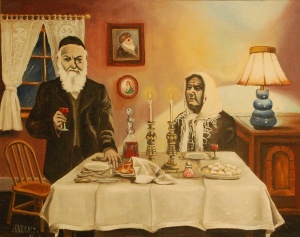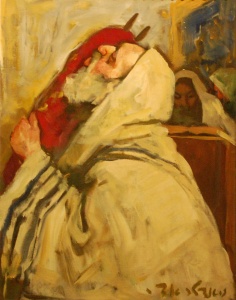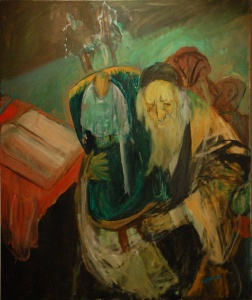The Jewish Gallery
Something is blooming in Brooklyn that promises a dramatic revitalization of Jewish visual culture. While it has been a long time a coming, nonetheless it is cause for heartfelt celebration, and, most importantly, your support. On May 9th Aryeh L. Wuensch and Isaac Gross opened The Jewish Gallery, an art gallery in Dumbo (Down Under the Manhattan Bridge Overpass) totally devoted to Jewish Art. This relatively modest space is located on the third floor of 147 Front Street in a trendy upscale building smack in the heart of the cutting edge gallery district. Considering its location the gallery clearly looks forward to attracting a sophisticated clientele imbued with an interest and openness to Jewish Art in all its myriad forms. These facts alone begin to fulfill some of my wildest dreams for a resurgent Jewish visual art.
While it is true that metropolitan New York has three museums devoted to Jewish culture the actual opportunities for the exhibition and sale of contemporary Jewish art are distinctly limited. Additionally these museums have tended to be rather conservative in their exhibition choices and are unfortunately chronically under funded. The only other commercial Jewish gallery, the Chassidic Art Institute in Crown Heights, limits its exhibitions to Chassidic themed art. The Jewish Gallery in Dumbo intends to explore a much broader spectrum of Jewish pictorial experience.
Aryeh Wuensch is a curator / gallerist based in Miami, Florida and this new gallery is his first foray into the New York gallery scene. His private gallery, Lionsgallery.com, is well stocked with both Jewish and non-Jewish works of art in all media, over a thousand works in all. Additionally he has a wide range of connections in the art world with access to many different kinds of artworks. He is well poised to cater to diverse variety of tastes. Additionally, this new venture may the first on the part of a gallerist who also happens to be a rabbi. From his initial selections it is clear that he sees Jewish Art from the inside.
The opening exhibition represents a middle of the road survey of 20th century Israeli, American, Russian and post-Soviet Jewish art. The 40 works, mostly paintings, range in subject from Israeli landscapes and street scenes, Jewish weddings, Hasidim, family portraits and lots of rabbi paintings.
The majority of the artists are not internationally well-known names. A good example is Yitzchak Frenkel (1899-1981), born in Odessa, Ukraine, and considered an important Israeli artist. He was a great-grandson of Rabbi Levi Yitzchok of Berditchev. After making aliyah he traveled to France and became part of the Jewish School of Paris that included Chagall, Soutine, Modigliani, Mane-Katz and Pascin. Back in Israel he founded an art school in Tel Aviv and, in addition to his extensive landscape painting, worked in set design at HaBimah, worked in stained glass and did portraits of the 120 members of the first Knesset. His expressionist painting of Safed Sunset is a gem of passionate impasto brushwork that seethes with emotion. Not surprising considering that he made his home there from 1934 (well before it became a famed artist’s colony) until he died in 1981.

Even more obscure is William Samuel Schwartz (1896-1997) who created Shabbat Dinner (1958). He is a mostly unknown painter who Wuensch nonetheless chose simply because he was drawn to the work’s singular view of a typical Shabbos experience. An electric table lamp supplements the Shabbos candles already lit on the table. The challah is ready, as is the bright-eyed fish and even the wife’s wine glass is filled. What strikes one is that the master of the house, almost certainly having just made kiddush, is staring out at the viewer with a most quizzical expression, surprised at what seems to be a photographic intrusion. His wife looks dutifully at her husband as we seem to have intruded on a moment of domestic bliss. Their faces are sharply detailed photographic portraits, in contrast to the simpler rendering of the objects in the room, and are echoed in the ancestor portraits prominently displayed on the wall behind them. This painting reveals Shabbos as a deeply individual experience that reverberates through the generations through the fabric of a couple’s intimate relationship.

Rabbi in Prayer with Torah by Jankel Adler (1895-1949) is another example of the profoundly eclectic approach of the gallery. While the artist is not immediately known, the image is easily etched into ones imagination as combination of mystery and rock solid composition. The triangular form of the rabbi in profile dominates the two smaller figures behind him who are sitting and learning at shtenders. But what is this figure actually doing with the Torah. We don’t normally prance around with the holy Torah, therefore this painting shifts into a symbolic mode expressing our emotions not normally acted out in the physical world.

At the well attended opening the room was filled with orthodox singles and couples chatting animatedly in front of the international array of paintings. Artists from Russia, Israeli, Poland, Lithuania, Germany, France, Italy, Argentina, and America were represented on the walls. Two large paintings that hung near the door demanded my immediate attention. They set the tone for rest of the exhibition. Probably done within the last decade, these Hyman Bloom paintings, both titled Rabbi with Torah, dominated the room. Bloom at 94 years of age is a living legend. His early Jewish paintings of the late 1930’s including The Bride and Rabbi combined an expressionistic technique with a probing examination of their subjects. The Synagogue, representing a crowded bimah in shul during Kol Nidre, was purchased by the Museum of Modern Art in 1943. Jackson Pollack and Willem de Kooning considered Bloom “the first Abstract Expressionist in America” and after his 1954 retrospective at the Whitney Museum of American Art his career was assured. But Bloom was determined to follow his own path and withdrew from the New York art world, pursuing paintings of séances, autopsies, lurid still lifes, fish and landscapes. In the late 1990’s he began painting rabbis in large scale compositions that questions the very nature of the religious experience he had grown up with in Latvia in 1913 And how did these two paintings find their way to The Jewish Gallery? Aryeh Wuensch and Itchie Gross made a pilgrimage a few months ago to Nashua, New Hampshire to the reclusive Bloom to discuss exhibiting his work. They were successful and returned with a number of his late paintings of rabbis. This one, 48” by 40,” explores the relationship between the Torah, central in its rich green mantle, the ancient seated Jew clasping it, and a sefer open on the shtender next to him. It’s a very special moment filled with wistfulness, a unity between a Jew and his holy Law that nonetheless is mediated by other texts that stem from the hand of man.
Creating a gallery of Jewish Art means making critical choices. The quality of the artwork must relate equally with the quality of images and their meanings. The inaugural exhibition at the Jewish Gallery shows sensitivity to both quality and content, happily an auspicious beginning.
The Jewish Gallery
147 Front Street, unit 305
Brooklyn, New York, 718 852 5100
Sunday to Thursday, 2 – 7pm or by appointment
Lionsgallery.com